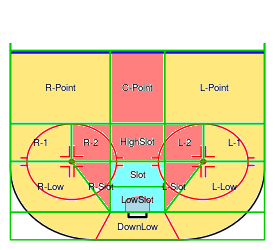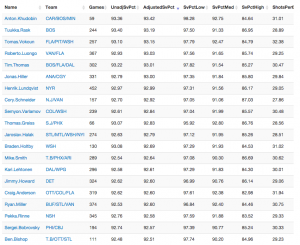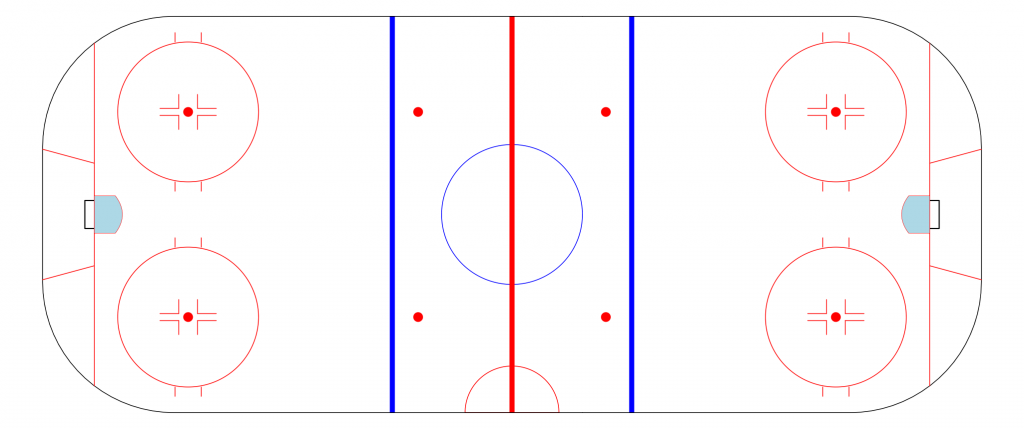When we demonstrated the goalie statistics and goalie history pages, we omitted precise definitions of some of the statistics offered on these pages. In particular, statistics like “Adjusted Save%”, “Save% High”, “Save% Med”, and “Save% Low” are new to the #fancystats literature, and deserve their own definitions.
To start, note that we provide definitions for each of these metrics on our Glossary page. We encourage readers to read our definitions of AdjustedSavePct, SvPctHigh, ScPctMed, and SvPctLow before reading any further.
Also, don’t forget to check out this graphic from our Glossary page, which we’ll reference later in this post:

Save Percentage Zones:
blue = high percentage shots (SvPctHigh)
red = medium percentage shots (SvPctMedium)
yellow = low-percentage shots (SvPctLow)
Adjusted Save Percentage: Partitioning the Offensive Zone into Three Scoring Areas
NHL goaltenders do not compete on a level playing field: In any given game, some goaltenders face many difficult, close-range shots, while others face many easy, long-range shots. To account for this, we use “Adjusted Save Percentage”, which takes into account the “quality” of each shot they face based on the empirical league-wide shooting percentage from that area of the ice.
To do this, we used @acthomasca‘s Hextally, which partitions the offensive zone into 15 areas (see graphic above). When doing this, we found that there are three areas with similar empirical Fenwick shooting percentages since the 2008-09 season:

As such, we defined the following three (Fenwick) shooting percentage areas: High probability (10% and above; blue), Medium probability (3.1% to 10%; red), and Low probability (3.0% and below; yellow). We include “DownLow” in the low-probability area because shots from this area are very rare and missed shots likely to be unreported.
We should also note that we tried Rob Vollman’s “home plate” zone, but found that parts of “home plate” (e.g. our “slot” and “low slot”) had about double the Fenwick shooting percentages as other parts of “home plate” (e.g. R-2, L-2, R-Slot, L-Slot). In fact, Vollman’s “home plate” is just a combination of our medium and high probability zones (minus our “C-Point”). While it’s an excellent tool for scoring by hand, the precision of the data from the NHL allows us to refine these estimates further.
Finally, since having memorable names is important in hockey analytics, we propose such a scheme:
- High probability area (blue): “The Box”
- Medium probability area (red): “The Wrench”
- Low probability area (yellow): “The Perimeter”
Here’s a plot of the league-wide Fenwick shooting percentages each of the original 15 areas from Hextally (colored by Fenwick shooting percentage). See the clear three-zone distinction?

Back to Our Goalie Statistics:
Because of the empirical differences in shooting percentages across these three zones, we chose to evaluate goalie save percentages separately for each of these zones. For this reason, we list “SvPctHigh”, “SvPctMed”, and “SvPctLow” on our site.
Finally, since we still needed an all-in-one metric to summarize a goalie’s save percentage, we created “Adjusted Save%”. Adjusted Save% works similarly to Stephen Burtch’s dCorsi, in that it controls for factors that are outside of the player’s control. Burtch’s dCorsi controls for things like zone starts, quality of teammates, and quality of competition; adjusted save% controls for the number of shots a goalie faces from each one of the three shooting percentage zones. As such, goalies who face more high-percentage shots than average are not punished, and goalies who face more low-percentage shots than average are not rewarded, since these are (for the most part) out of their control. The exact derivation is the “benchmarked” save percentage, by correcting for the rates at which these shots occur league wide:
Adjusted Save Percentage = (SvPctLow * (All Low Shots) + SvPctMed * (All Med Shots) + SvPctHigh * (All High Shots))/(All Low Shots + All Med Shots + All High Shots)
The table below shows the even-strength adjusted save percentage leaders for all NHL goalies since the 2008-09 season.






